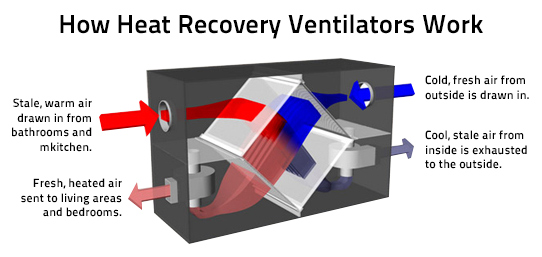The All-Inclusive Guide to the Uses of Heat Recovery Ventilation in Modern Buildings
Heat Recovery Ventilation (HRV) systems stand for a considerable development in constructing innovation (HRV Heat Recovery Ventilation). They provide a technique for exchanging stale interior air with fresh outside air while decreasing energy loss. This strategy not only boosts indoor air quality but additionally adds to power efficiency in both domestic and commercial structures. Understanding the numerous applications and benefits of HRV can reveal its important function in modern style and sustainability initiatives. The implications of this innovation deserve discovering even more
Understanding Heat Recovery Ventilation Equipments

Although lots of modern structures prioritize energy effectiveness, recognizing warm recuperation air flow (HRV) systems is vital for enhancing interior air quality and decreasing power intake. HRV systems function by moving warmth from stagnant interior air to inbound fresh air, effectively maintaining comfortable indoor temperatures while lessening power loss. These systems contain a warm exchanger, fans, and ductwork that help with the flow of air. During winter season, HRV units record and recycle warm from the outgoing air, while in summer, they can help cool incoming air. By constantly exchanging air, HRV systems also minimize moisture and the focus of indoor contaminants. Correct setup and upkeep of HRV systems are vital for their effectiveness and effectiveness in improving overall structure performance and convenience.
Advantages of Heat Recovery Ventilation
Heat recovery ventilation systems provide various advantages that boost both energy efficiency and interior air top quality in contemporary structures. By recording and recycling energy from exhaust air, these systems considerably decrease heating & cooling prices, bring about reduced energy consumption. In addition, they preserve a steady circulation of fresh outdoor air, decreasing the danger of indoor air toxins and allergens. This constant exchange aids control humidity levels, protecting against mold development and guaranteeing a much healthier living environment. In addition, HRV systems add to sustainability goals by decreasing general carbon impacts. Their ability to maximize ventilation without compromising thermal convenience makes them an important enhancement to contemporary structure design, promoting both financial and ecological advantages.
Applications of HRV in Residential Structures
As house owners significantly prioritize power performance and indoor air high quality, the applications of warmth recuperation air flow (HRV) systems in household structures have come to be much more common. HRV systems are especially beneficial in securely sealed homes, resource where preserving fresh air circulation is necessary for protecting against moisture accumulation and indoor toxins. They properly move heat from outward bound stale air to inbound fresh air, reducing energy expenses connected with heating and air conditioning. Additionally, HRVs can improve convenience degrees by managing moisture and temperature. They are also adaptable for different property layouts, consisting of single-family homes and multi-unit buildings. In general, incorporating HRV systems sustains lasting living techniques while making sure a much healthier indoor atmosphere for residents.
HRV in Industrial and Industrial Settings
In industrial and commercial settings, the implementation of warmth recuperation air flow (HRV) systems has ended up being increasingly vital for enhancing energy performance and preserving air top quality. These systems properly move warmth from exhaust air More hints to inbound fresh air, lowering the demand for extra heating or air conditioning. This not only decreases power costs yet likewise adds to sustainability campaigns. Industries such as manufacturing, warehousing, and office buildings profit considerably from HRV systems, as they assist regulate temperature level and humidity levels, guaranteeing a comfy and effective atmosphere. Additionally, HRV systems aid in removing impurities and excess wetness, enhancing indoor air high quality. As regulations around air high quality become more stringent, the adoption of HRV modern technology is most likely to grow, making it a vital part of contemporary business and industrial framework.
Future Patterns in Heat Recovery Ventilation Modern Technology

Often Asked Inquiries
Just How Does Heat Recovery Ventilation Effect Indoor Air Quality?
Heat recovery ventilation considerably improves indoor air quality by continuously exchanging stale interior air with fresh outside air while recouping power. This procedure reduces contaminants, maintains optimal moisture levels, and guarantees a healthier atmosphere for owners.
Can HRV Solutions Be Set Up in Existing Structures?
HRV systems can undoubtedly be mounted in existing buildings. Retrofitting may require alterations to ductwork and air flow designs, yet it considerably improves energy efficiency and indoor air quality, making it a viable choice for older frameworks.
What Upkeep Is Required for HRV Solutions?

Are There Particular Climates Where HRV Is More Reliable?
Heat recovery ventilation systems are especially effective in environments with considerable temperature differences between periods. These systems optimize power effectiveness by recouping warm from exhaust air, making them perfect for both cool and moderately cozy atmospheres.
How Do HRV Equipments Affect Power Expenses?
